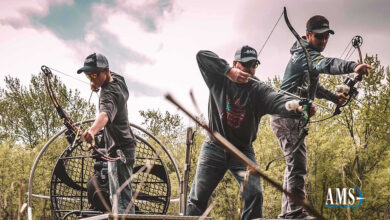Muskie vs Pike: The Ultimate Showdown
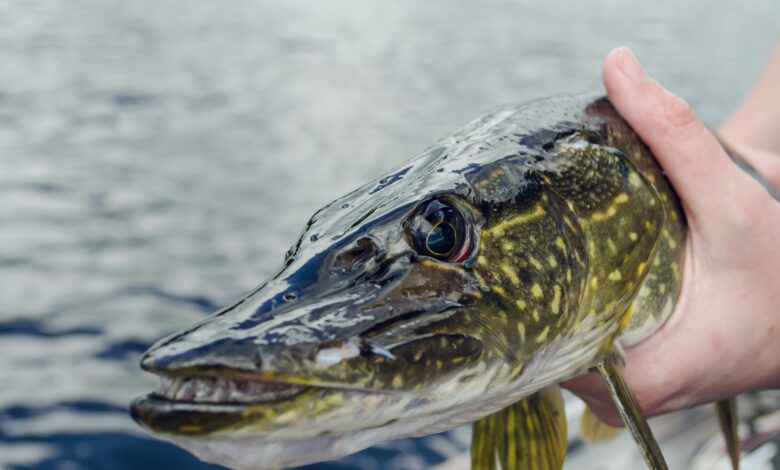
Imagine a streamlined, muscular body, swiftness, razor-sharp teeth, and stealth. Add to that the right amount of aggression and you have two fishes from the genus Esox which are freshwater killing machines.
When it comes to the predator fishing game, equipping yourself with the right gear is step number one. This is why I took to the water with the St. Croix Triumph, a powerful spinning rod that offers a surprising amount of sensitivity and strength.
The second step is knowing what you’re after. When you consider how similar but different these two fishes from the same genre are, the northern pike vs muskie debate gets even more interesting.
Before you plan to hunt these toothy predators, you need to know what sets these two freshwater giants apart. No matter which species you prefer, know that none of these two are known to land quietly.
Check out the video below from “A Sportman’s Life” on catching giant muskies in the St. Louis River!
Introducing Muskie
Muskellunge or muskie (or musky) are prized game fish for anglers in North America, mostly because of the thrill of the chase. With a long, cylindrical shape and the duckbill-like snout, it is the largest member of the Esox family.
Muskies are widely found in deep lakes, rivers, and streams in northern and northeastern parts of the US. They prefer cooler water temperatures- between 33 to 78 degrees Fahrenheit.
Muskies are fearless stealth predators and use their speed and strength to hunt and capture prey. In other words, they are the rulers of the lakes where they live. The bigger they are – some can be above 60 inches – the smarter and more selective they get about their prey. Besides, their feeding habits are dictated by water temperature, weather, and the moon phases.
With so many variables affecting how muskies feed, finding the right bait and the window of opportunity for them is a challenge. From there rises their reputation of being the “fish of 10,000 casts”. Utilizing specialized lures like the Guideline GTN Musky Slayer can increase your chances of a successful catch.
But once they bite, they fight like demons. I remember the ecstatic feeling I had, after landing my first muskie.
Introducing Pike
The Northern Pike is another freshwater predator found in lakes and slow-flowing rivers and streams in almost every state in the US. Just like the muskie, the pike has a duck-billed-shaped snout and a slender torpedo-shaped body.
Not surprising as they both belong to the Esox family. This is one reason that many anglers find the pike difficult to distinguish from the muskie.
They can tolerate a wide range of water temperatures and can survive in lightly turbid waters as well. The pike prefers water with a lot of vegetation which it uses as hiding spots.
As a lie-in-wait predator, it is not so selective about its prey, and sometimes its diet includes the smaller pikes as well. This almost insatiable hunger makes them more willing to bite a wide range of baits. Now is when you want to go big with a large multi jointed swimbait.
Even though some of these freshwater beasts can grow more than four feet in length, they are relatively easier to catch. In fact, hooking them may seem easier than filleting them. However, if you can use the right techniques to get rid of those y-bones, the pike is one of the best-tasting freshwater fishes to catch.
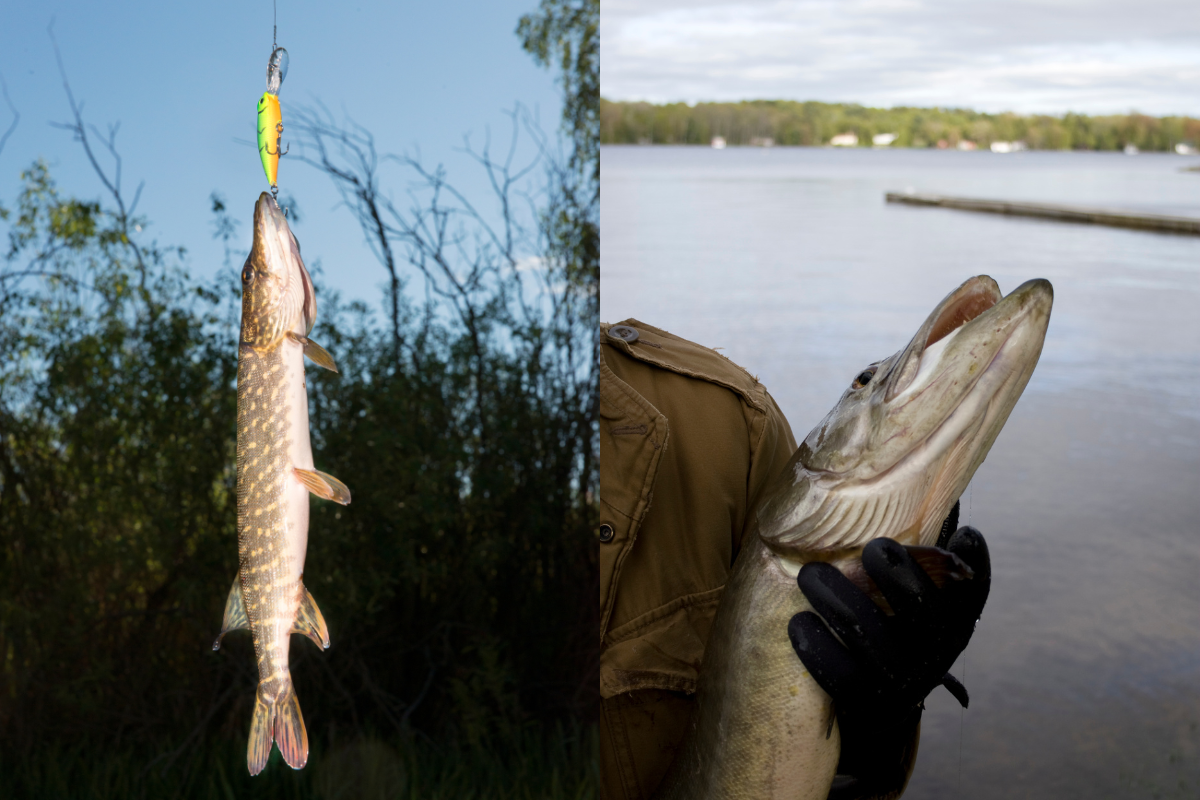
Understanding the Physical Differences
Regarding the physical aspects of the northern pike vs muskie debate, we need to consider that both are natural predators. Since they look similar, only upon closer inspection, do the differences become clear. Here are some physical differences that will help you distinguish between the two.
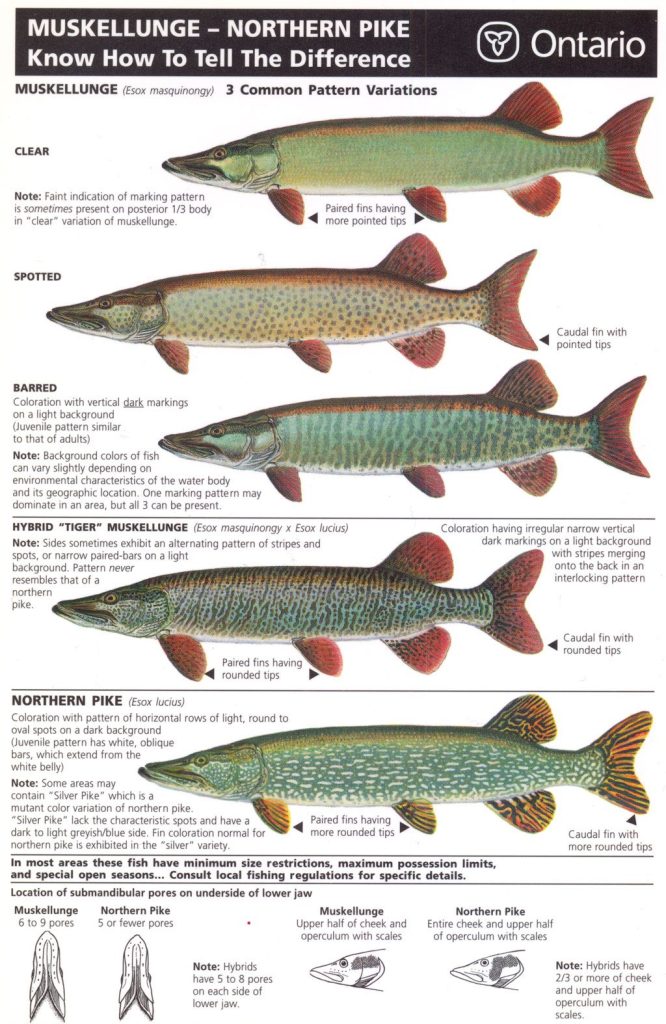
Ministry of Natural Resources and Forestry Detailed Images for Musky and Pike. Credit to Steve Statland & Rod Ramsell.
Size and Weight Comparison
Generally, the northern pike has a narrower girth than the muskie. In terms of length, the average pike is around two feet while the average muskie is bigger.
The biggest muskie ever caught was back in 1949. Louie Spray caught this 69-pound 11-ounce giant with a length of 63.5 inches in Wisconsin. Coming to pike, the largest specimen was caught by Lothar Louis in 1986. Caught in Lake Greffern, Germany, this fish weighed 55 pounds, 1 ounce.
More than often, the denser population of pike in some lakes leads to a lack of food resources. This results in the fish reaching sexual maturity too early, and ending up undersized due to lower food availability. That also makes catching pike a lot easier.
In contrast, muskies prefer segregated water bodies and their population is more balanced. That means you have to look around in a large water body to find the right spot for baiting a muskie.
Coloration and Markings
Muskies can be between green to silver with vertical dark markings. The background shade can vary depending on the water characteristics and the environment. Some muskies can be “clear” as well, with a greenish-silvery devoid of patterns.
On the other hand, the northern pike has dark green skin with round or oval lighter spots on their flanks. The base color pattern on them is brighter and more uniform. The color of the back is dark green which appears almost black. This helps them to blend in underwater environments.
If you consider the tiger muskie- a female muskie and male pike hybrid- it has bright vertical stripes on the body. This striking-looking variety has a larger head length as well as a longer tail fin.
What makes things more confusing is the presence of spotted muskies with skin that looks similar to the spotted pattern on northern pikes. In such cases, it is best to check the other physical characteristics.
Body Shape and Fins
Being close relatives, both fish have a long and sleek body that gives them the ability to move fast. Both muskies and Northern pikes have pectoral, pelvic anal, and dorsal fins. Generally, the dorsal and pelvic fins in pikes are slightly rounded and larger than muskies.
Size and strength play a big role in overpowering and catching their prey. Then they use their sharp teeth to finish them off. Muskies can hide patiently till the prey comes near and then make an explosive move to catch it between their sharp teeth.
One clear physical difference between the two is the number of sensory or submandibular pores on the jaws of the two species which act as sense organs. These can be spotted on the underside of the lower jaw for both species. Northern pike generally have four or five of these pores. However, muskies have anywhere between 6 to 9 pores.
While both species have forked tails, the muskie has more pointed tail edges. In pikes, the tail is more rounded. Another difference is in the distribution of facial scales. In muskies, scales cover only half the face. But the entire face of pikes is covered with scales.
Even though they do not attack humans, there have been reports of musky attacks. Honestly, the first time I saw that muskies have teeth even on their tongues, I was shocked! The numerous sharp teeth in their lower jaws and the roof of the mouth make it necessary to handle them in the right manner.
Muskie vs. Pike Habitat
Being a native fish of North America, the muskellunge are found in the Great Lakes and their connecting channels, the St. Lawrence River, Hudson Bay (Red River), and Mississippi River basins. The Wisconsin River systems and the Ohio River drainage in West Virginia are good musky waters. Muskies usually prefer large lakes and rivers with clear waters.
Pikes are more abundant and most states have a healthy population. Alaska, Michigan, Minnesota, New York, and Wisconsin are some of the best pike states. The streams and reservoirs in the Dakotas and Colorado are also good spots.
Take Wisconsin as an example. The muskellunge density in the state is 1 adult fish for every 3 surface acres, That means a 2500-acre water body will have a muskie population of sound 833.
The population density of northern pikes varies a lot depending on the location, However, the density is higher than muskies. One study in Minnesota estimates the density at 8.3 fish/acre for fish larger than 13.8 inches.
Unlike the musky, northern pikes are not so particular about the water type they live in and are found in smaller water bodies as well. Both pike and muskie prefer relatively shallow waters and you will seldom find them below depths of 40 feet.
Aggression and Predatory Nature
Admittedly, muskies have an aura of mystery around them. It is often said that you only see a muskie when they let you. I have heard veteran anglers talking about the feeling of being watched while on the water and sensing a muskie before seeing it. Now, that is why it is the perfect ambush predator.
Recent research suggests that larger muskies are less exploratory and aggressive and the reputation of being the “Fish of 10,000 Casts” suits them. So, you must cast where they are resting to get them interested. Another interesting fact is that muskies are sensitive to angling pressure. So, the bigger ones can still be elusive no matter the type of lure you use.
It seems that these lazy buggers love to remain comfortable in their favorite corner without moving much. Sounds familiar?
This study also shows that the catch rate depends on musky behavioral traits. The overall catch rate dropped significantly once the larger fish in a reservoir were caught and removed. That means catch and release is the best option to keep the sport of muskie fishing alive.
A quick warning here. Make sure not to fish for a musky once the water temperature crosses the 80-degree mark. The fish are more vulnerable in such temperatures and less likely to survive.
In contrast, pikes are polar opposites. They are more than willing to bite on a large variety of lures, no matter their size or color. Yes, there have been days when I have found them to be tricky. But overall, your success rate with pikes will be much higher than with muskies.
I have used soft plastics, topwater lures, spinnerbaits, and swimbaits to catch pikes and never found them to be painfully particular about their diet preferences.
With muskies, you need to learn the art of coaxing them with the lure. They are curious by nature and often tend to follow a lure before striking. Remember, patience is the key here.
Diet and Prey
Young muskellunge feed on smaller fish like minnows and other smaller baitfish. Fully grown muskies will eat any other fish in their habitat, including suckers, bass, carp, sunfishes, and even trout and smaller muskies.
They will also feed on amphibians, living animals, small rodents, waterfowl, and invertebrates. The larger size of the stomachs allows them to consume larger prey like small reptiles and ducklings.
The young pikes feed on small insects. Gradually, they start hunting other fish, some of which are almost half their size. As they grow, their aggressiveness increases and they develop cannibalistic tendencies as well. Their dinner menu includes shiners, perch, bass, snakes, frogs, and birds.
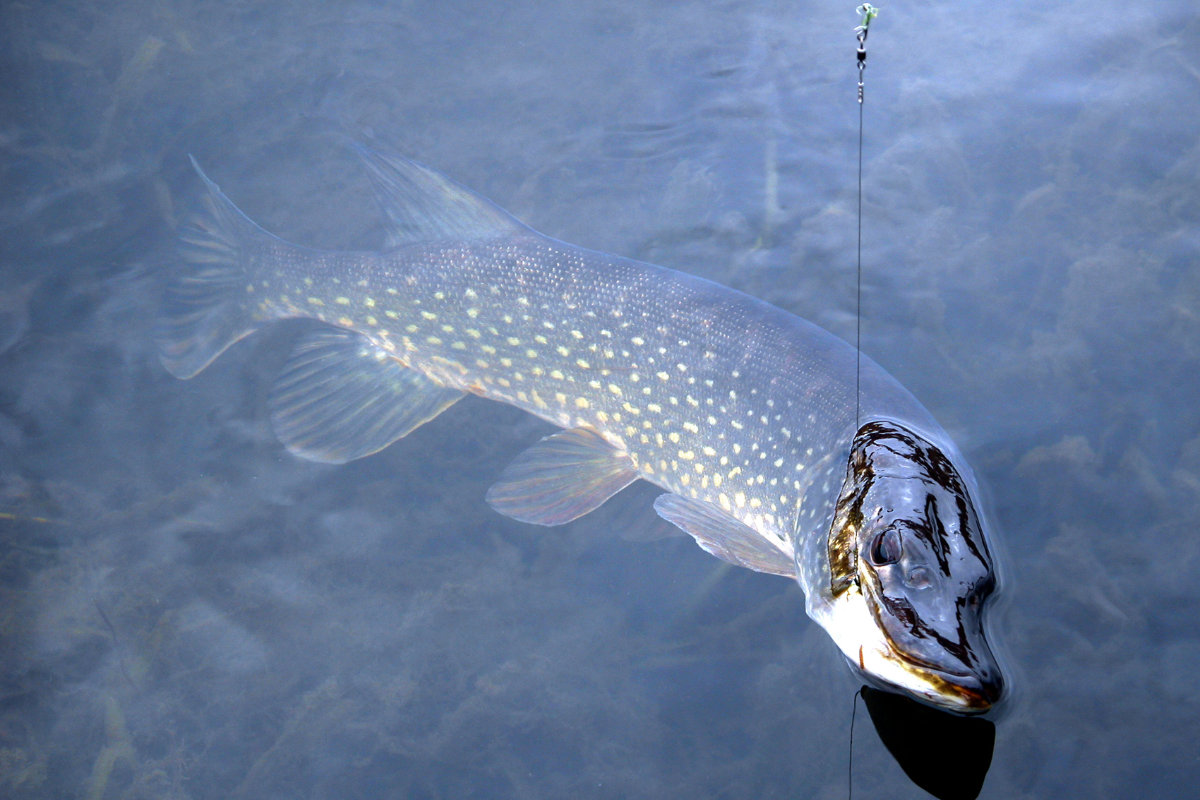
How to Catch Pike and Muskie
When it comes to catchability, the muskellunge is harder to catch than the Northern Pike. Pikes are super aggressive and that makes them fun. Not that muskies are any less entertaining. You might see them making an acrobatic jump and throwing the hook.
Even with the differences between pike and muskie in terms of their feeding tendencies, the fishing techniques for both fish overlap to some extent. Since they are predators, spots that offer the best combination of food and cover are the best locations.
Structures that provide cover, like fallen trees, flooded timbers, and edges of weed beds are spots that can hold the biggest muskies.
Beds of milfoil and hydrilla where the water depth is between 3- to 8 feet are good hiding spots for muskies. Pikes can be found around offshore flats and secondary coves as these are hanging spots for baitfish.
If you feel the pike following the lure you can allow it to settle down to the bottom. But with muskies, you need to keep it moving by going into the figure 8. I will suggest using razor-sharp hooks as these fish have bony mouths. Since they have a sharp bite, using a heavy leader is also a good idea.
Fall is one of the best periods for targeting these fish. Use larger baits as they will be eager to stock up for the winter. When the water is colder, I have found smaller baits to work well.
Pike and musky do not remain fully inactive in winter and while they move more slowly, they continue ambushing prey. If you are visiting an area where muskie season does not close in winter, chances are, you will find their behavior more predictable in this period. Try using a combination of presentation techniques and when they are ready to feed expect solid strikes.
Frequently Asked Questions
What fights harder, musky or pike?
Muskies generally fight harder than pike due to their larger size, explosive strikes, and unpredictable movements. However, pike are more aggressive overall and put up a strong initial fight, but muskies tend to have greater endurance and power.
Are muskies good to eat?
While muskies are edible, they are not considered the best-tasting fish. Their meat can be bony and have a strong, fishy flavor. Many anglers prefer to catch and release muskies due to their rarity and role as top predators in the ecosystem.
Are pike good eating?
Yes! Northern pike are quite good to eat if prepared properly. They have firm, white meat with a mild flavor, but their Y-bones can make cleaning tricky. Many anglers enjoy pike in fried, grilled, or pickled dishes.
Why are pike so aggressive?
Pike are aggressive because they are opportunistic ambush predators with a high metabolism, meaning they need to eat frequently. Their sharp teeth and quick strikes help them dominate their environment, attacking anything that moves, including fish, frogs, and even small birds.
Final Thoughts
In the end, the muskie vs pike debate is about two similar species that remain dissimilar.
While the unpredictability of muskies makes them a more prized catch. Even though hooking them is easier, the northern pikes are no less fun with their super-aggressive nature. Overall, the thrill you get from hunting these freshwater monsters is unlike any other type of fishing.
So do not expect a relaxing fishing trip when you are going after the muskie or the pike. However, if you are looking for a challenge, you will hardly find any other fish species more fun. While the angling techniques for these fish may differ, be ready for a battle.



